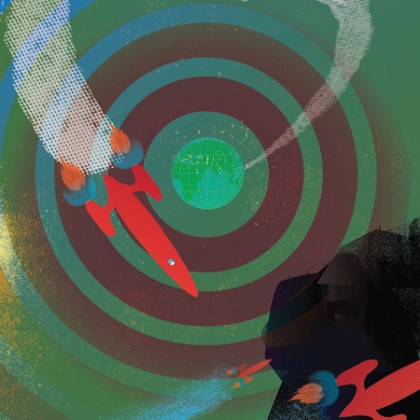Earth might feel like a pretty safe planet to call home—nestled comfortably between Venus and Mars, near enough to the sun to feel its warmth but far enough away not to get burned. But this ball we live on hurtles through space at more than 60,000 mph, and that space is peppered with thousands of rocky objects. It's been well-documented that sometimes huge chunks of space stuff collide with our planet, demolishing the impact site, affecting global climate, and devastating populations. So, what if we discovered a large asteroid coming our way? Surprisingly little research has been done so far on that question. But Andy Cheng, chief scientist of the Space Department at the Applied Physics Laboratory, has an idea: Ram a spacecraft into a nearby asteroid and see what happens. That could take us a step closer to better understanding how we might defend ourselves in the face of looming catastrophe.
How It Works

Image credit: Mark McGinnis
"One of these days, almost certainly, an asteroid is going to be predicted to be able to hit Earth," Cheng says. "What do you do? Well, let's try to move it into a different orbit. One of the ways you could think of doing that is to crash a spaceship into it." Cheng's project, dubbed AIDA—Asteroid Impact and Deflection Assessment—is a joint mission with NASA/APL and the European Space Agency. It requires two crafts: the spacecraft that will crash into the asteroid and an orbiting probe to measure what happens. Cheng's target is the smaller of a pair of asteroids, which orbits the larger one like a moon. The orbiting probe, which is ESA's part of the mission, is scheduled to launch in August 2019 and will collect data on the asteroid before the other spacecraft slams into it in 2022. Once the collision occurs, the ESA probe will be able to measure the change in the asteroid's orbit, and the scientists will better understand the physics of deflection. "It's all about what the target is essentially made of, how strong it is, how porous it is—all these things we just don't know," Cheng says. "It's very hard to predict the result."
Data
"Earth lives in a dangerous neighborhood," Cheng says. Astronomers estimate there are about 1,000 near-Earth asteroids larger than 1 kilometer—big enough to cause a global disaster. About 90 percent of them have been identified. Far less is known about smaller asteroids. All told, about 100 tons of extraterrestrial matter falls onto Earth every day, mostly in the form of harmless dust and an occasional meteorite. Cost caps have been set for $150 million for NASA and 150 Euros for ESA.
Upshot
Once the impact occurs, scientists will better understand how a collision affects the orbit of an asteroid, potentially leading to a better way to protect Earth. One of the benefits of the mission design, Cheng says, is that if either craft fails, or if ESA or NASA rescinds its commitment—which is not that uncommon for international collaborations—the remaining craft can still perform a worthwhile mission. ESA's probe would be able to collect valuable data on asteroids, and if it is never launched, the change in the asteroid's orbit after the impact of NASA's craft still could be measured from the ground, albeit less accurately than from space. Regardless of how the mission shakes out, scientists will know more about the rocky bodies that share Earth's space.
Conclusion
Other solutions to the asteroid problem have been proposed, most notably using a nuclear bomb to deflect orbit. But, Cheng points out, there's no real way to test that. NASA conducted a mission in 2005 called Deep Impact that crashed a craft into a comet—an icy body much different from an asteroid—but its main goal was to study the composition of the comet, not its deflection after impact. AIDA will provide a better understanding of how impacts change the trajectory of an asteroid, so in the event of a real pending collision, we'll be more prepared.
Posted in Science+Technology
Tagged applied physics laboratory, space, andy cheng









